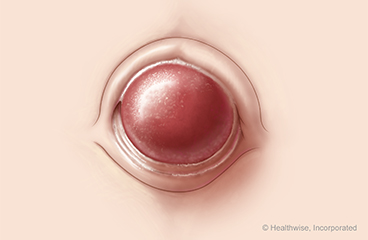Overview
An umbilical granuloma is a moist, red lump of tissue that can form on a baby's navel (belly button). It can be seen in the first few weeks of life, after the umbilical cord has dried and fallen off. It's usually a minor problem that looks worse than it is. An umbilical granuloma does not cause pain. It may ooze a small amount of fluid that can make the skin around it red and irritated.
Your child's doctor may treat the granuloma if it doesn't go away by itself. The doctor may:
- Apply silver nitrate to shrink and slowly remove the granuloma. It may take 3 to 6 doctor visits to finish the treatment.
- Use surgical thread to tie off the granuloma at its base. The thread cuts off the blood supply to the granuloma. This will make it shrivel and fall off.
Neither of these treatments is painful.
Follow-up care is a key part of your child's treatment and safety. Be sure to make and go to all appointments, and call your doctor if your child is having problems. It's also a good idea to know your child's test results and keep a list of the medicines your child takes.


